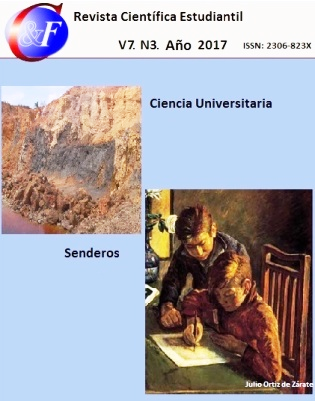Phytochemical and bromatological characterization of Thalassia testudinum used in the feeding of pelibuey sheep from Cuba (Ovis aries)
Keywords:
characteristic phytochemical, secondary metabolites, Thalassia testudinum, animal feeding, sheepAbstract
The research was developed in the property” Los Morenos” in the municipality Media Luna in Granma province had as purpose to evaluate some characteristic phytochemical and presence of secondary metabolites of 40 ovinos male pelibuey of Cuba weaned to the 120 days and divided in four treatments, it was included in the diet of three, of them tender leaves of the seagrassThalassia testudinum and leaves and tender shafts of the leguminous Leucaena leucocephala, the used methodology was a totally randomized design applied to the treatments to which were carried out the following evaluations and characteristic phytochemical like (MS, PB, FND, FAD, ca, p, EM, DMS, DMO), the presence of secondary metabolites was also determined as (Cumarins, Quinonas, Sugars reducers, Phenols, Tannins, Groups α-amines, flavonoids, Glycosides cardiotónics, Catequina, Triterpenos and steroids, Alkaloids, Polysaccharides, Antocianidinas) in what was determined bigger quantity of Alkaloids and Groups α-amines.Downloads
References
ASSOCIATION OF OFFICIAL ANALYTICAL CHEMISTS (AOAC). 2000: Official Methods of Analysis. 17 ed. Association of Official Analytical Chemists, Washington, D.C. Consultado: 13 enero 2016. Disponible en: www.sigmaaldrich.com/catalog/product/aldrich/z423645
BARNES, R. F. & GUSTINE, D. L. 1973: Allelochemistry and forage crops. En: Antiquality components of forages. Crop Science Society of America, p. 1-13. Disponible en: https://dl.sciencesocieties.org/publications/books/pdfs/.../1
BELMAR, R. 2001: Importancia de los factores antinutricionales en la alimentación de animales no rumiantes. En: X Congreso de Veterinaria (Memorias). Universidad Autónoma de Yucatán, Yucatán, p. 34-54.
BELMAR, R. & NAVA, R. 2005: Factores antinutricionales en la alimentación de animales monogástricos. En: VII Encuentro de Nutrición y Producción de Animales Monogástricos. Curso Pre-evento. UNELLEZ, Venezuela.
BERENBAUM, M. R. 1991: Coumarins. In: ROSENTHAL, G. A. & BERENBAUM, M. R. (Ed.) Herbivores: TheirInteractions with Secondary Plant Metabolites. Vol. I. Academic Press, New York, p. 221-249.
CASAS-VALDEZ, M., HERNÁNDEZ-CONTRERAS, H., MARÍN-ÁLVAREZ, A., AGUILA-RAMÍREZ, R. N., HERNÁNDEZ-GUERRERO, C. J., SÁNCHEZ-RODRÍGUEZ, I., & CARRILLO-DOMÍNGUEZ, S. (2006). El alga marina Sargassum (Sargassaceae): una alternativa tropical para la alimentación de ganado caprino. Revista de biología tropical 54(1): 83-92. Disponible en: https://revistas.ucr.ac.cr/index.php/rbt/article/download/14002/13314
CHEEKE, P. R. & KELLY, J. D. 1989: Metabolism, toxicity and nutritional implications of quinolizidine (lupin) alkaloids. In: Recent advances of research in antinutritional factors in legume seeds. Proceedings of the Firts International Workshop on 'Antinutritional Factors (ANF) in Legume Seeds', Wageningen, The Netherlands, November 23-25.
D´MELLO, J. P. F. 1995: Anti-nutricional substances in legumes seeds. In: D´MELLO, J. P. F. & DEVENDRA, C. (Eds.) Tropical Legumes in Animal Nutrition. CAB International. U.K., p. 135-165. Disponible en: eprints.ibu.edu.ba/id/document/2758
DUPONT, M. S.; MÚZQUIZ, M.; ESTRELLA, I.; FENWICK, G. R. & PRICE, K. R. 1994: Relationship between the Sensory Properties of Lupin Seed with Alkaloid and Tannin Content. Journal of the Science of Food and Agriculture 65(1): 95-100. Disponible en: onlinelibrary.wiley.com/doi/10.1002/jsfa.2740650114/pdf
HARBORNE, J. B. 2014: Introduction to Ecological Biochemistry. Academic Press, London.
JANSMAN, A. J. M.; HUISMAN, J. & VAN DER POEL, A. F. B. 1989: Faba beans with different tannin contents: ileal and faecal digestibility in piglets and growth in chicks. Recent Advances in Research of Antinutritional Factors in Legume Seeds. Wageningen Academic Publishers, Pudoc, Wageningen, The Netherlands, 176-180.
LEINMÜLLER, E.; STEINGASS, H. & MENKE, K. H. 1991: Tannins in ruminant feedstuff. Anim Res Dev 8: 9-62. Disponible en: igital.csic.es/bitstream/10261/35659/.../Pablo%20G.%20Toral.d.
MOLYNEUX, R. J. & RALPHS, M. H. 1992: Plant toxins and palatability to herbivores. Journal of Range Management 45: 13-18. Disponible en: https://journals.uair.arizona.edu/index.php/jrm/article/.../8289
NATIONAL RESEARCH COUNCIL (N.R.C.) 1981: Nutrient requirements of goats. National Academy, Washington, D.C., EE.UU. 91 p.
NATIONAL RESEARCH COUNCIL (N.R.C.) 2001: Nutrient requirements of dairy cattle. National Academy, Washington, D.C., EE.UU. 202 p.
SLIWINSKI, B. J.; SOLIVA, C. R.; MACHMÜLLER, A. & KREUZER, M. 2002: Efficacy of plant extracts richin secondary constituents to modify rumen fermentation. Animal Feed Science and Technology 101(1): 101-114. Disponible en: www.sciencedirect.com/science/article/pii/S0377840102001396.
VAN SOEST, P. J. 1994: Nutritional ecology of the ruminant. 2 ed. Cornell University Press, Ithaca, NY. Disponible en: www.scirp.org/.../reference/ReferencesPapers.aspx?ReferenceID.
VENTURA, M. R. & CASTAÑÓN, I. 1998: The nutritive value of seaweed (Ulva lactuca) for goats. Small Ruminant Research 29(3): 325-327. Disponible en: www.sciencedirect.com/science/article/pii/S092144889700134X.
Published
How to Cite
Issue
Section
Esta obra está bajo una Licencia Creative Commons Reconocimiento-NoComercial 4.0 Internacional
La Revista Ciencia & Futuro es una revista de acceso abierto, todo el contenido está disponible gratuitamente sin cargo para el usuario o su institución. Los usuarios pueden leer, descargar, copiar, distribuir, imprimir, buscar o vincular los textos completos de los artículos, o utilizarlos para cualquier otro fin lícito, sin pedir permiso previo al editor o al autor. Todo lo anterior, de acuerdo con la definición de BOAI de acceso abierto.
Los autores que publican en esta revista están de acuerdo con los siguientes términos: Licencia Creative Commons Atribución-NoComercial permite que el beneficiario de la licencia tenga el derecho de copiar, distribuir, exhibir y representar la obra y hacer obras derivadas para fines no comerciales siempre y cuando reconozca y cite la obra de la forma especificada por el autor o el licenciante. Los autores pueden establecer por separado acuerdos adicionales para la distribución no exclusiva de la versión de la obra publicada en la revista (por ejemplo, situarlo en un repositorio institucional o publicarlo en un libro), con un reconocimiento de su publicación inicial en esta revista. Se permite y se anima a los autores a difundir sus trabajos electrónicamente (por ejemplo, en repositorios institucionales o en su propio sitio web) antes y durante el proceso de envío, ya que puede dar lugar a intercambios productivos, así como a una citación más temprana y mayor de los trabajos publicados (Véase The Effect of Open Access) (en inglés). Lo anterior debe realizarse siempre sobre el artículo ya publicado por Ciencia & Futuro.
Los autores mantienen el control sobre la integridad de sus trabajos y el derecho a ser adecuadamente reconocidos y citados.
A los editores se les otorgan derechos no exclusivos para publicar y distribuir.






